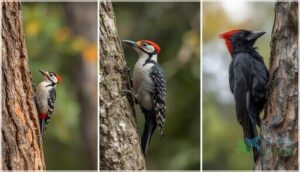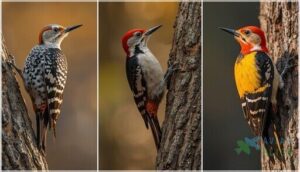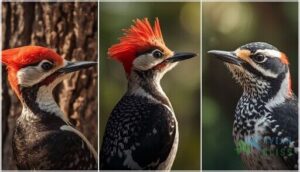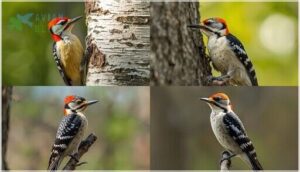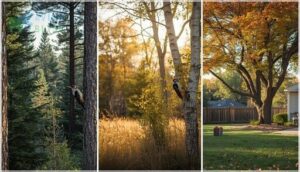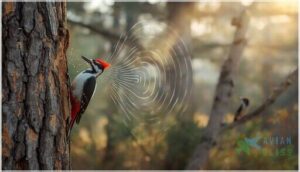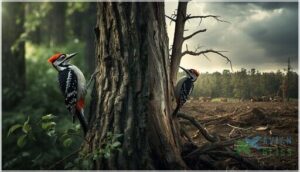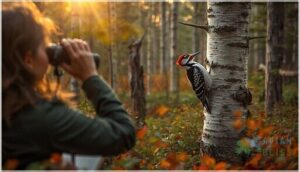This site is supported by our readers. We may earn a commission, at no cost to you, if you purchase through links.
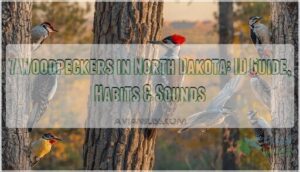
Stand under the right tree in North Dakota’s forests, and you might witness something wild—a bird drilling into bark with the force of 1,000 times Earth’s gravity, yet walking away without a headache. That’s just one of the extraordinary adaptations woodpeckers bring to the prairie state’s woodlands.
Seven distinct species call North Dakota home, from the crow-sized Pileated Woodpecker hammering away at dead cottonwoods to the sparrow-sized Downy tapping on backyard feeders.
Learning to identify these drummers isn’t just about spotting field marks—it’s about understanding who’s carving out cavities in your neighborhood oak, whose territorial rhythm echoes through Theodore Roosevelt National Park at dawn, and which species might surprise you by showing up at your suet feeder mid-winter.
Table Of Contents
- Key Takeaways
- Woodpecker Species Found in North Dakota
- Key Identification Features of Woodpeckers
- Woodpecker Habitats Across North Dakota
- Distribution and Range of Woodpeckers
- Behavior and Feeding Habits
- Woodpecker Calls and Sounds
- Attracting Woodpeckers to Your Backyard
- Conservation Status and Threats
- Tips for Identifying Woodpeckers in The Field
- Frequently Asked Questions (FAQs)
- Are woodpeckers good to have in your yard?
- Are woodpeckers protected in North Dakota?
- Why do red-headed woodpeckers peck on trees?
- What is the difference between a Red-headed Woodpecker and an acorn woodpecker?
- What sounds do woodpeckers make and what do they mean?
- How do woodpeckers help control insect populations?
- Can woodpeckers cause damage to homes and how can it be prevented?
- What types of food do woodpeckers eat at bird feeders?
- When do woodpeckers in North Dakota breed?
- How long do North Dakota woodpeckers live?
- Conclusion
Key Takeaways
- North Dakota hosts seven distinct woodpecker species ranging from the sparrow-sized Downy to the crow-sized Pileated, with some staying year-round while others migrate south by October, making seasonal timing crucial for successful identification.
- The Red-headed Woodpecker has declined by 50% since 1966 and now holds Level I priority conservation status in North Dakota, with only 7,000 individuals remaining due to an 80% loss of woodland habitat since European settlement.
- Each species has carved out unique feeding niches—Yellow-bellied Sapsuckers drill sap wells, Northern Flickers hunt ants on the ground, and Pileated Woodpeckers target carpenter ants—reducing competition while showcasing extraordinary adaptations to North Dakota’s ecosystems.
- You can attract woodpeckers to your yard by providing suet feeders, leaving dead trees standing for nesting cavities, and maintaining pesticide-free native plantings, transforming suburban spaces into functional wildlife habitat that supports these essential insect controllers.
Woodpecker Species Found in North Dakota
North Dakota’s forests and grasslands host seven distinct woodpecker species, each with unique markings and behaviors that make identification easier once you know what to look for. You’ll find everything from the tiny Downy Woodpecker to the crow-sized Pileated Woodpecker, with some species sticking around year-round while others only pass through during migration.
Here’s what you can expect to see if you’re watching the trees and listening carefully.
Yellow-bellied Sapsucker
The Yellow-bellied Sapsucker stands out among woodpeckers in North Dakota through its unique feeding behavior—drilling neat rows of sap wells in birches and maples. You’ll recognize this migratory species by:
- Red throat patch on males (white on females)
- Distinctive white wing stripe
- Mottled black-and-white back pattern
- 8.5-inch robin-sized body
- Preference for aspen groves during breeding season
Watch for their northward migration from late March through early May. The species’ migratory patterns can be further understood by studying its woodpecker habitats.
Red-headed Woodpecker
While sapsuckers drill precise rows, the Red-headed Woodpecker breaks the mold entirely. You’ll spot this bold rebel by its unmistakable scarlet head—no patches or stripes, just solid crimson glory. At 9.25 inches with a 17-inch wingspan, this species faces serious conservation efforts across North Dakota’s 7,000-strong population.
| Feature | Description |
|---|---|
| Red Crown | Entire head covered in bright red |
| Body Pattern | Black back, white wing patches |
| Nesting Habits | Cavities 5-80 feet high, reused yearly |
| Feeding Strategies | Catches insects mid-flight, caches nuts |
Their woodpecker migration pattern runs mid-April through October, with breeding peaking June to August along river bottoms and shelterbelts. Unlike other woodpeckers in North Dakota that drill constantly, Red-headed woodpeckers forage on the ground and shrubs, storing acorns and beetles in bark crevices for later. Immature birds show brown heads—watch for that transformation as they mature into one of the most striking woodpecker species in North Dakota.
The conservation status of the Red-headed Woodpecker is a concern due to habitat conservation efforts.
Northern Flicker
Shifting from solid scarlet to spotted elegance, the Northern Flicker stands out among woodpeckers in North Dakota with its ground-feeding habits. Ants make up 45% of the flicker diet. You’ll recognize this common species by its barred back, spotted breast, and those signature yellow wing flashes during flight.
Northern flicker migration brings breeding visitors north each spring, with 11 million individuals across North America choosing semi-open habitats over dense forests for their distinctive nesting habits.
Pileated Woodpecker
From ground-dwellers to tree giants, you’ll spot North Dakota’s largest woodpecker species in mature forests. The Pileated Woodpecker swings a crow-sized presence through woodlands, its distinctive red crown catching your eye against deep forest shadows.
These powerhouse excavators carved their way into North Dakota during the early 1900s, expanding westward from the Red River Valley into new territories.
Hairy Woodpecker
You’ll recognize the Hairy Woodpecker by its larger size—about 7 to 10 inches—and longer, chisel-like bill. Males sport a red patch on the nape, while females don’t.
This species thrives across North Dakota year-round, from suburban backyards to mature forests. Watch them work over tree cavity surfaces during insect foraging, especially targeting wood-boring beetle larvae that make up most of their diet.
Downy Woodpecker
You’ll find the Downy Woodpecker is North Dakota’s smallest woodpecker species at just 5–7 inches. Males have that signature red patch on the back of the head—females don’t.
Their backyard birding tips include watching for:
- Stubby, short bill distinguishing them from Hairy Woodpeckers
- Black-and-white striped face and white back
- Acrobatic foraging techniques on small branches and weed stalks
- Year-round presence across deciduous woodlands and suburban yards
Their feeding strategies target beetle larvae, ants, and caterpillars.
Red-bellied Woodpecker
You might miss the Red-bellied Woodpecker‘s subtly reddish belly at first, but you won’t overlook that striking red crown extending down the nape. This woodpecker’s rare outside summer in North Dakota, with small populations in southeastern regions.
Males forage along tree trunks while females work higher limbs. They nest in tree cavities about 27 cm deep, favoring mature deciduous woodlands and suburban areas with dead wood.
Key Identification Features of Woodpeckers
When you’re out in the field, knowing what to look for makes all the difference between a quick glance and a confident ID. Woodpeckers share some common traits, but the details—size, color patterns, and head markings—tell you exactly which species you’ve spotted.
Let’s break down the key features that’ll help you identify these birds with clarity and precision.
Size and Body Shape
When identifying woodland birds in the field, body proportions tell you more than you’d expect. You’ll notice dramatic size variations among woodpecker species—from the compact Downy at just 5.5-6.7 inches to the crow-sized Pileated stretching 16-19 inches.
Pay attention to these woodpecker physical features:
- Bill sizes: Downy’s short bill versus Hairy’s head-length chisel
- Tail lengths: compact on smaller species, elongated on larger ones
- Head shapes: rounded on Red-headed, prominent crests on Pileated
These woodpecker characteristics make species identification straightforward once you know what matters.
Color Patterns and Markings
Each species displays unique plumage variation that makes field identification reliable. You’ll spot the Yellow-bellied Sapsucker’s bold black and white bars against its brown back, while the Red-headed shows that unmistakable bright red spot covering its entire head.
Northern Flickers reveal yellow wing shafts in flight, and males sport that diagnostic black mustache stripe—feather colors that separate them instantly from look-alikes.
Distinctive Head and Crown Features
Crown coloration cuts straight to the ID chase. You’ll notice three standout patterns:
- Red-headed Woodpecker – that complete red spot covering the entire head separates it instantly
- Pileated Woodpecker – sports a dramatic triangular red crest reaching up from mature forest canopies
- Northern Flicker males – display a red crescent on the nape plus that diagnostic black mustache stripe
Head shape and facial markings lock down your identification every time.
Sexual Dimorphism in Woodpeckers
Beyond crown patterns, you’ll find males and females show subtle but reliable differences. Male yellow-bellied sapsuckers flash both red crown and throat, while females skip the throat color entirely. Notice the mustache stripe on northern flickers—that’s your male marker.
| Species | Male Feature | Female Feature |
|---|---|---|
| Pileated Woodpecker | Red cheek stripe present | No cheek stripe |
| Red-bellied Woodpecker | Red crown and nape | Red nape, white crown |
| Downy/Hairy Woodpecker | Small red head patch | No red patch |
Size variations exist too, though they’re tougher to spot without direct comparison.
Woodpecker Habitats Across North Dakota
North Dakota’s woodpeckers aren’t locked into one habitat—they’ve adapted to find food and shelter across a surprising range of environments. From deep forests to your own backyard, each species has carved out its niche based on food availability and nesting requirements.
Let’s break down the three main habitat types where you’re most likely to spot these birds in action.
Forested Areas and Mature Woodlands
Mature forests are where you’ll find North Dakota’s woodpecker diversity at its peak. These woodland ecosystems provide the tree canopy, dead wood, and insect-rich forest floors essential for their survival. The ecosystem services mature woodlands deliver include:
- Standing dead trees offering prime nesting cavities
- Abundant wood-boring insects within rotting timber
- Diverse tree species supporting varied foraging techniques
- Riparian corridors creating regional hotspots
- Large-diameter trunks accommodating cavity excavation
Woodland management preserving these features ensures healthy woodpecker habitats across forested areas.
Suburban Backyards and City Parks
You don’t need ancient forests to spot woodpeckers—your backyard can surprise you. Downy Woodpeckers and Northern Flickers show up in nearly every city park and suburban yard with mature trees.
Backyard habitat creation matters: leaving deadwood standing, planting native oaks or maples, and skipping pesticides creates the insect-rich conditions these birds need. Even small green spaces with 75% canopy cover can rival natural woodlands for woodpecker diversity.
Dead Trees and Open Woodlands
Open woodlands and forests scattered through North Dakota’s river valleys hold the real key to woodpecker diversity. Dead trees—or snags—aren’t eyesores; they’re ecological goldmines for cavity-nesters. Why it matters for ecosystem conservation:
- Red-headed Woodpeckers nest 5-80 feet up in dead oak, ash, or cottonwood
- Eight snags per hectare boosts woodpecker presence to 75-80%
- Deadwood ecology sustains 20-25% of all forest biodiversity
- Tree snag management and woodland restoration preserve nesting sites for 40+ bird species
Forest biodiversity thrives where woodpecker habitats include strategic deadwood retention during North Dakota woodpecker identification surveys.
Distribution and Range of Woodpeckers
Not all woodpeckers stick around North Dakota year-round, and understanding their movements helps you know when and where to find them. Some species are permanent residents, while others migrate through or show up only during certain seasons.
Let’s break down which woodpeckers you can count on seeing throughout the year and how their ranges shift with the seasons.
Year-round Vs. Migratory Species
Not all woodpecker species stick around when winter rolls in. Year-round residents like the Downy, Hairy, and Pileated Woodpeckers maintain their territories through North Dakota’s coldest months. In contrast, Yellow-bellied Sapsuckers and Red-headed Woodpeckers migrate south by October, following seasonal shifts. Northern Flickers exhibit mixed patterns—some stay, while others move depending on habitat preferences and food availability.
| Species | Status | Notes |
|---|---|---|
| Downy Woodpecker | Year-round | Common winter resident |
| Yellow-bellied Sapsucker | Migratory | Departs before winter |
| Red-headed Woodpecker | Migratory | Leaves by October |
| Northern Flicker | Partial Migrant | Variable movement |
Migration patterns in these woodpecker species reflect habitat preferences and food sources. Conservation efforts increasingly focus on protecting both breeding grounds and migration corridors for declining populations.
Regional Hotspots for Birdwatching
If you’re serious about spotting woodpeckers in North Dakota, these locations deliver. Across western prairies to northern forests, you’ll find concentrated populations at:
- Theodore Roosevelt National Park – Red-headed and Pileated Woodpeckers along riparian zones
- Turtle Mountain State Forest – expanding Pileated populations in dense woodlands
- Lostwood Refuge – year-round residents in mixed wetland habitats
- Kelly’s Slough and Bowman-Haley – accessible trails with consistent sightings
Seasonal Movement Patterns
Understanding migration routes reveals how woodpeckers navigate North Dakota’s changing seasons. Yellow-bellied Sapsuckers head south to Mexico and Central America by September, while Red-headed Woodpeckers arrive mid-April for breeding, then depart by October. Northern Flickers show partial migration with short-distance movements. Downy and Hairy Woodpeckers stay year-round, demonstrating habitat shifts based on food availability rather than long-range seasonal movement.
Behavior and Feeding Habits
Woodpeckers aren’t just tree climbers—they’re resourceful foragers with techniques that vary wildly depending on the species and season. Each one has carved out its own niche, from drilling into bark for hidden insects to sipping sap or even hunting on the ground.
Let’s break down how these birds find their meals, what they eat, and how their iconic drumming plays into communication and territory.
Foraging Techniques
Ever wonder how these birds find hidden meals beneath layers of bark? You’ll spot woodpeckers using several clever pecking strategies to access their insect diet, each technique refined over millions of years:
- Bark scaling — peeling away chunks to reveal concealed prey
- Ground foraging — Northern Flickers excel at extracting ants from soil
- Sap feeding — Yellow-bellied Sapsuckers drill distinctive sap wells
Their foraging behavior varies by tree selection and available resources.
Diet Variation by Species
Each species carves out its own nutritional niche, with specialized diets shaped over millennia. Yellow-bellied Sapsuckers rely on sap wells and cambium year-round, while Pileated Woodpeckers target carpenter ants, which make up 60% of their intake. Northern Flickers shift foraging strategies seasonally, with ants dominating spring diets and berries sustaining them through winter.
This dietary specialization reduces competition and showcases extraordinary nutrient acquisition adaptations among woodpecker species.
Drumming and Communication
Drumming replaces song as the primary territorial marking and mating signal for woodpeckers. This communication behavior peaks during late winter and early spring, when fitness and dominance are most critical. Identifying woodpeckers by sound becomes easier once you recognize their distinct drumming patterns.
Here are the key patterns to listen for:
- Hairy Woodpeckers drum incredibly fast at 25+ taps per second
- Downy Woodpeckers produce slower drums around 15 taps per second
- Pileated Woodpeckers deliver about 15 beats that fade toward the end
Sound analysis reveals these rhythmic differences help declare territory and attract mates on resonant surfaces.
Woodpecker Calls and Sounds
Woodpeckers don’t rely on song like most birds—they communicate through sharp calls and rhythmic drumming that echo through forests and backyards. Each species has its own vocal signature and drumming style, which makes sound one of the most reliable ways to identify them in the field.
Here’s what you need to know about the calls, drumming patterns, and seasonal variations that’ll help you recognize North Dakota’s woodpeckers by ear.
Common Vocalizations
When you’re exploring woodpeckers in North Dakota, learning to identify their calls and acoustic signals opens up a whole new way to track these birds. Sound waves from these bird calls reveal patterns—larger species deliver deeper tones than smaller ones like Downy Woodpeckers.
The Pileated Woodpecker’s loud “cuk-cuk-cuk” carries through mature forests, while Northern Flickers produce that distinctive “wick-a-wick-a-wick” you’ll hear in city parks.
Drumming Patterns for Identification
Beyond those calls, you can use drumming speed to pin down which woodpecker you’re hearing. Hairy Woodpeckers fire off roughly 26 beats per second—nearly twice as fast as Downys at 17 beats. Rhythm analysis and spectrogram use reveal these beat patterns clearly:
- Downy Woodpeckers drum slowly for about 0.8 seconds with distinct spacing between pecks
- Pileated Woodpeckers build intensity then fade at 15 beats per second
- Black-backed Woodpeckers produce the longest drums, lasting nearly 2 seconds
That drumming isn’t random—it’s territorial signaling that helps you master woodpecker identification across North Dakota’s landscapes.
Seasonal Changes in Calls
You’ll notice vocal seasonality shifts dramatically throughout the year. Breeding signals dominate March through June—Northern Flickers emit laugh-like territorial drumming while Yellow-bellied Sapsuckers telegraph their presence. By October, migration cues trigger quieter behavior as birds prepare to leave or hunker down for winter.
| Season | Call Patterns |
|---|---|
| Spring (Mar-Jun) | Peak breeding signals, intense territorial drumming |
| Fall (Sep-Oct) | Reduced vocalizations, migration cues emerge |
| Winter | Minimal activity, sporadic calls during mild weather |
Attracting Woodpeckers to Your Backyard
If you want to bring woodpeckers into your yard, you’ll need to think beyond just hanging a feeder. These birds look for specific resources—reliable food, safe places to nest, and an environment that doesn’t work against their natural habits.
Here’s how to create a space that actually appeals to them.
Providing Food Sources
If you want to roll out the welcome mat for woodpeckers, start with suet feeders—they’re essential, especially when winter hits. Add peanut offerings and sunflower seeds to attract downy, hairy, and red-bellied woodpeckers year-round.
Mealworm supplements boost protein intake, while fruit attractions and diverse seed varieties keep bird feeders buzzing with activity. Understanding woodpecker feeding habits makes all the difference.
Creating Suitable Nesting Sites
The real breakthrough for cavity nesters lies in mimicking nature’s blueprint. Here’s how you support woodpecker nesting and breeding:
- Leave standing dead trees (snags) at least 25 cm diameter—cavity depth in these structures reaches 8–24 inches
- Install nest box designs with 3-inch entrance holes for northern flickers
- Place artificial cavities 5–80 feet high near foraging zones
- Maintain tree selection diversity with mature stands for pileated woodpecker species
Natural nesting cavities trump manufactured ones, but smart bird identification helps you position boxes where they’ll actually work.
Tips for Safe and Bird-friendly Yards
With the right setup, your yard becomes a sanctuary for woodpeckers instead of just another stop on their route. Native plantings like oak and serviceberry support woodpecker diet naturally, while bird baths provide essential water.
Keep bird feeders clean, ditch pesticides for yard safety, and add window decals—these eco-friendly gardens transform backyard birding from wishful thinking into daily reality.
Conservation Status and Threats
While most of North Dakota’s woodpeckers are holding steady, not all species are thriving in the changing landscape. Some face real pressures from habitat loss, while others find themselves at odds with human structures and activities.
Let’s look at the conservation challenges these birds encounter and what they mean for their future in the state.
Declining Populations (Red-headed Woodpecker)
The Redheaded Woodpecker faces a sobering reality—population trends show a staggering 50% decline across North America since 1966, with North Dakota shifting the species from “Fairly common” to “Rare” status. You’re witnessing a species decline that demands attention:
- Annual decline rate of -2.59% continues relentlessly
- North Dakota populations now estimated at just 7,000 individuals
- Conservation efforts elevated this woodpecker to Level I priority status in 2015
Habitat Loss and Fragmentation
North Dakota’s woodlands have shrunk by 80% since European settlement—a catastrophic loss driving woodpecker conservation status into crisis. Forest fragmentation has slashed habitat into isolated patches, reducing breeding pairs by 50% in small woodlots.
North Dakota’s woodlands have collapsed 80% since settlement, cutting woodpecker breeding pairs in half through catastrophic fragmentation
Woodland conservation and ecosystem connectivity have become urgent priorities as biodiversity loss accelerates. Habitat restoration targeting oak savannas and snag retention offers hope for reversing wildlife conservation declines across these essential forests.
Human-Wildlife Conflicts and Management
You’ll find woodpecker damage most often on wood-sided homes and EIFS buildings, where drilling creates costly repairs—sometimes thousands of dollars.
Conflict resolution starts with non-lethal wildlife management like bird netting, which protects both human safety and conservation efforts. Since all species hold protected conservation status under federal law, habitat modifications and deterrents must come before permits.
Effective woodpecker conservation balances wildlife conservation with practical woodpecker behavior management.
Tips for Identifying Woodpeckers in The Field
Spotting woodpeckers in the wild takes more than just luck—you need to know what to look for and where to focus your attention. The key is combining visual field marks with behavioral clues and understanding which species belong in specific habitats.
Here’s how to sharpen your identification skills and make the most of every outing.
Using Field Marks and Behavior
You can pin down woodpecker species in North Dakota by combining sharp visual cues with behavioral clues. Watch for these key identifying characteristics:
- Plumage patterns: Note black-and-white bars, spotted underparts, or fully red heads
- Beak shapes: Compare bill length—Hairy Woodpeckers sport longer beaks than Downys
- Drumming techniques: Listen for tempo differences; Pileated drums are slower and louder
- Flight characteristics: Flickers show undulating flight with flashing wing colors
- Nesting behaviors: Pileated Woodpeckers carve rectangular excavations in dead trees
Identifying woodpeckers by sight works best when you pair visual field marks with woodpecker calls and sounds plus woodpecker behavior patterns.
Noting Habitat and Range
You’ll boost your ID accuracy by checking where you’re standing. Pileated Woodpeckers stick to mature forests near rivers, especially in the Turtle Mountains and Sheyenne National Grassland. Red-headed Woodpeckers favor river-bottom woodlands and shelterbelts from mid-April through October. Hairy and Downy Woodpeckers adapt to both woodland ecosystems and suburban yards.
Knowing these habitat preferences and range expansion patterns helps narrow down woodpecker species in North Dakota before you even raise your binoculars.
Tools for Birdwatchers (Field Guides, Apps)
Once you’ve narrowed habitat and range, the right tools seal the deal. Digital resources like the Merlin Bird ID app give you photo and sound recognition that works offline—essential for North Dakota’s remote spots. The Sibley Guide to Birds offers detailed illustrations for Woodpecker species identification, while eBird logs your sightings and taps you into real-time community data.
Solid birding software and mobile apps make ornithology accessible:
- Instant field confirmation builds confidence
- Shared discoveries connect you to fellow observers
- Accurate IDs fuel conservation awareness
Frequently Asked Questions (FAQs)
Are woodpeckers good to have in your yard?
Absolutely—woodpeckers are nature’s pest control squad, devouring thousands of wood-boring insects annually. They boost yard biodiversity, create essential cavities for backyard birds, and transform suburban areas into thriving, eco-friendly wildlife conservation hubs with woodpecker-friendly gardens attracting diverse species.
Are woodpeckers protected in North Dakota?
Yes, woodpeckers enjoy federal protections under the Migratory Bird Treaty Act throughout North Dakota.
State regulations reinforce these protection laws, making it illegal to harm them without wildlife permits—even when they’re causing property damage.
Why do red-headed woodpeckers peck on trees?
Red-headed woodpeckers peck trees for several reasons: foraging for insects, excavating nesting cavities, and drumming on resonant surfaces.
They forage for insects like beetles and larvae beneath bark, excavate nesting cavities in dead wood, and drum to communicate territorially and attract mates.
What is the difference between a Red-headed Woodpecker and an acorn woodpecker?
These distinctively different drummers show Physical Differences in head patterns—solid scarlet versus white face with red cap—plus Habitat Preferences: Red-headed favor eastern forests while Acorn Woodpeckers inhabit western oak woodlands, rarely overlapping in range.
What sounds do woodpeckers make and what do they mean?
Woodpeckers use drumming on resonant surfaces to mark territory and attract mates.
Vocal calls—like churrs, rattles, and tchur notes—signal alarm, maintain pair bonds, and communicate individual identity during social interactions.
How do woodpeckers help control insect populations?
Their relentless foraging drives insect populations down by 70% in individual trees. By targeting wood-boring beetles and larvae beneath bark, they maintain ecological balance and reduce pest outbreaks naturally—true biological management at work.
Can woodpeckers cause damage to homes and how can it be prevented?
Yes, they can peck holes in wood siding searching for insects or building nests. You’ll want to try bird deterrents like reflective tape or netting, and reducing insect populations in your woodwork helps discourage their interest.
What types of food do woodpeckers eat at bird feeders?
Like hungry artists at a buffet, these birds flock to suet first—especially peanut-flavored varieties. Black oil sunflower seeds, shelled peanuts, and mealworms round out their favorite feeder menu year-round.
When do woodpeckers in North Dakota breed?
Breeding season kicks off when Pileated Woodpeckers start nesting in early March, followed by Northern Flickers and Yellow-bellied Sapsuckers in spring.
Red-headed Woodpeckers breed through early summer, with fledging times varying by species.
How long do North Dakota woodpeckers live?
North Dakota woodpecker longevity varies dramatically by species. Downy woodpeckers usually survive just one to two years, while pileated woodpeckers can reach seven to ten years.
Mortality rates, habitat quality, and predation pressure shape these age variation patterns markedly.
Conclusion
Think of each woodpecker as a thread in North Dakota’s ecological tapestry—pull one loose, and the whole weave weakens. Now that you’ve learned to distinguish drumming patterns, field marks, and habitat preferences, you’re equipped to decode the rhythms echoing through prairie woodlands.
Whether you’re tracking the crow-sized Pileated through Theodore Roosevelt’s forests or welcoming Downies to your suet feeder, recognizing woodpeckers in North Dakota transforms every walk into a chance to witness resilience in action.

